|
325-794-4100 ext. 2825
Tutoring Times:
Tuesday, Wednesday and Thursday
3:40 – 4:30 pm (other times available by appointment)
Parent Conferences:
I am available sixth period for conferences.
Contact the counselor’s office to set one up. Students can access current lessons on Google Classroom and library and textbook resources on ClassLink.
|
“The most beautiful thing we can experience is the mysterious. It is the source of all true art and science.”
– Albert Einstein
“Men (and Women) love to wonder, and that is the seed of science.”
– Ralph Waldo Emerson
Thanks for visiting my website. My name is Jason Barber and I am thrilled about teaching science at Craig. This is such a fun and exciting subject. In seventh grade we focus a great deal on life science and we also look at some earth science, space, physics and chemistry. We will learn about photosynthesis, ecosystems, cells, human body systems and so much more. It will be a great year!
Being raised here, I am a proud graduate of Abilene High School. GO EAGLES! In 1999 I earned a Bachelors degree from Abilene Christian University.
My journey to become a teacher is very unique. After working many years in business I felt like something was missing. I was working hard and doing well but I wasn’t making a real difference. In 2010 I began working as a substitute teacher just to see if it was the change I was looking for. Needless to say, on the first day it “clicked.” I should have done this years ago. Inspiring students and seeing their minds grow is the most rewarding experience I could have wished for. I am proud to be a part of the wonderful team at Craig.
In 2016 a beautiful new theater teacher was hired at Craig. A few months later we began dating and in 2019 we were married at the Grace Museum!

|
|
|
|
8th Grade Washington, D.C. Trip
I am a co-sponsor of the Spring Break trip to Washington, D.C. If you interested in the trip contact me or go the the WorldStrides website to learn more.
It is an amazing experience! Seventh graders interested in going next year should start preparing now.
It is an amazing experience! Seventh graders interested in going next year should start preparing now.






In 2018 I was part of a group of science teachers that launched a series of high altitude balloons. Our balloons reached altitudes over 36 kilometers (120,000 feet). These are some of the images we captured:
- Abilene and Lake Fort Phantom, This was several days after a significant rain event and you can see the highly turbid water flowing into the lake.
- Space visible
- Abilene and Lake Fort Phantom
- Atmosphere, clouds and space visible
- Abilene and space
- Balloon launch
- Moments after balloon burst
- Freefall
- Sun visible
In June 2014 I traveled with a group of middle and high school science teachers to Big Bend National Park. It was a great experience. To see some the amazing pictures and videos from the journey visit our flickr page.
|
My Best Links:
|
My Favorite Youtube Channels: My youtube channel (Check out the playlists!) Amoeba Sisters Animal Logic CrashCourse Kurzgesagt – In a Nutshell Mark Rober Minute Earth Minute Physics NASA SciShow Smarter Everyday TED-Ed Veritasium Vsause |
Seventh Grade Science Vocabulary
| English | Español |
|
| A | B | C | D | E | F | G | H | I | J | K | L | | M | N | O | P | Q | R | S | T | U | V-Z | |
| abrasion (uh·BRAY·zhuhn) the process by which rock is reduced in size by the scraping action of other rocks driven by water, wind, and gravity. | abrasión proceso por el cual se reduce el tamaño de las rocas debido al efecto de desgaste de otras rocas arrastradas por el agua, el viento o la gravedad |
| accuracy (AK·yer·uh·see) a description of how close a measurement is to the true value of the quantity measured | exactitud término que describe qué tanto se aproxima una medición al valor verdadero de la cantidad medida |
| acid precipitation (AS·id prih·sip·ih·TAY·shuhn) rain, sleet, or snow that contains a high concentration of acids |
precipitación ácida lluvia, aguanieve o nieve que contiene una alta concentración de ácidos |
| active transport (AK·tiv TRANS·pohrt) the movement of substances across the cell membrane that requires the cell to use energy | transporte activo el movimiento de sustancias a través de la membrana celular que requiere que la célula gaste energía |
| adaptation (ad·ap·TAY·shuhn) an inherited trait that improves an individual’s ability to survive and reproduce in a particular environment | adaptación un carácter heredado que mejora la capacidad de un individuo para sobrevivir y reproducirse en un determinado ambiente |
| allele (uh·LEEL) one of the alternative forms of a gene that governs a characteristic, such as hair color |
alelo una de las formas alternativas de un gene que rige un carácter, como por ejemplo, el color del cabello |
| alluvial fan (uh·LOO·vee·uhl FAN) a fan-shaped mass of material deposited by a stream when the slope of the land decreases sharply | abanico aluvial masa en forma de abanico de materiales depositados por un arroyo cuando la pendiente del terreno disminuye bruscamente |
| alveolus (al·VEE·uh·luhs) tiny, thin-walled, capillary-rich sac in the lungs where the exchange of oxygen and carbon dioxide takes place; also called air sac (plural – alveoli) | alveolo saco diminuto ubicado en los pulmones, de paredes delgadas y rico en capilares, en donde ocurre el intercambio de oxígeno y dióxido de carbono |
| antibody (AN·tih·bahd·ee) a protein made by B cells that binds to a specific antigen | anticuerpo una proteína producida por las células B que se une a un antígeno específico |
| aquifer (AH·kwuh·fer) a body of rock or sediment that stores groundwater and allows the flow of groundwater | acuífero un cuerpo rocoso o sedimento que almacena agua subterránea y permite que fluya |
| artery (AR·tuh·ree) a blood vessel that carries blood away from the heart to the body’s organs | arteria un vaso sanguíneo que transporta sangre del corazón a los órganos del cuerpo |
| artificial selection (ar·tuh·FISH·uhl sih·LEK·shuhn) the human practice of breeding animals or plants that have certain desired traits | selección artificial la práctica humana de criar animales o cultivar plantas que tienen ciertos caracteres deseados |
| asexual reproduction (ay·SEK·shoo·uhl ree·pruh·DUHK·shuhn) reproduction that does not involve the union of sex cells and in which one parent produces offspring that are genetically identical to the parent |
reproducción asexual reproducción que no involucra la unión de células sexuales, en la que un solo progenitor produce descendencia que es genéticamente igual al progenitor |
| atmosphere (AT·muh·sfir) a mixture of gases that surrounds a planet, moon, or other celestial body | atmósfera una mezcla de gases que rodea un planeta, una luna, u otras cuerpos celestes |
| atom (AT·uhm) the smallest unit of an element that maintains the properties of that element | átomo la unidad más pequeña de un elemento que conserva las propiedades de ese elemento |
| axon (AK·sahn) an elongated extension of a neuron that carries impulses away from the cell body | axón una extensión alargada de una neurona que transporta impulsos hacia fuera del cuerpo de la célula |
|
| A | B | C | D | E | F | G | H | I | J | K | L | | M | N | O | P | Q | R | S | T | U | V-Z | |
| barrier island (BAIR·ee·er EYE·luhnd) a long ridge of sand or narrow island that lies parallel to the shore | isla barrera un largo arrecife de arena o una isla angosta ubicada paralela a la costa |
| B cell (BEE SEL) a white blood cell that makes antibodies | célula B un glóbulo blanco de la sangre que fabrica anticuerpos |
| beach (BEECH) an area of the shoreline that is made up of deposited sediment | playa un área de la costa que está formada por sedimento depositado |
| behavior (bih·HAYV·yer) an action that an individual carries out in response to a stimulus or to the environment | conducta una acción que un individuo realiza en respuesta a un estímulo o a su ambiente |
| biodiversity (by·oh·dih·VER·sih·tee) the number and variety of organisms in a given area during a specific period of time | biodiversidad el número y la variedad de organismos que se encuentran en un área determinada durante un período específico de tiempo |
| biome (BY·ohm) a large region characterized by a specific type of climate and certain types of plant and animal communities | bioma una región extensa caracterizada por un tipo de clima específico y ciertos tipos de comunidades de plantas y animales |
| biotechnology (by·oh·tek·NAHL·uh·jee) the use and application of living things and biological processes | biotecnología el uso y la aplicación de seres vivos y procesos biológicos |
| blood (BLUHD) the fluid that carries gases, nutrients, and wastes through the body and that is made up of platelets, white blood cells, red blood cells, and plasma | sangre el líquido que lleva gases, nutrientes y desechos por el cuerpo y que está formado por plaquetas, glóbulos blancos, glóbulos rojos y plasma |
| brain (BRAYN) the organ that is the main control center of the nervous system | encéfalo el órgano que es el centro principal de control del sistema nervioso |
| bronchus (BRAHNG·kuhs) one of the two main branches of the trachea that lead directly to the lungs; plural, bronchi | bronquio una de las dos ramificaciones principales de la tráquea que conducen directamente a los pulmones |
|
| A | B | C | D | E | F | G | H | I | J | K | L | | M | N | O | P | Q | R | S | T | U | V-Z | |
| capillary (KAP·uh·lehr·ee) a tiny blood vessel that allows an exchange between blood and cells in tissue | capilar diminuto vaso sanguíneo que permite el intercambio entre la sangre y las células de los tejidos |
| carbohydrate (kar·boh·HY·drayt) a class of molecules that includes sugars, starches, and fiber; contains carbon, hydrogen, and oxygen | carbohidrato una clase de moléculas entre las que se incluyen azúcares, almidones y fibra; contiene carbono, hidrógeno y oxígeno |
| carbon cycle (KAR·buhn SY·kuhl) the movement of carbon from the nonliving environment into living things and back | ciclo del carbono el movimiento del carbono del ambiente sin vida a los seres vivos y de los seres vivos al ambiente |
| cardiovascular system (kahr·dee·oh·VAS·kyuh·ler SIS·tuhm) a collection of organs that transport blood throughout the body; the organs in this system include the heart, the arteries, and the veins | aparato cardiovascular un conjunto de órganos que transportan la sangre a través del cuerpo; los órganos de este sistema incluyen al corazón, las arterias y las venas |
| carnivore (KAR·nuh·vohr) an organism that eats animals | carnívoro un organismo que se alimenta de animales |
| cell cycle (SEL SY·kuhl) the life cycle of a cell | ciclo celular el ciclo de vida de una célula |
| cell theory (SEL THEE·uh·ree) the theory that states that all living things are made up of cells, that cells are the basic units of organisms, that each cell in a multicellular organism has a specific job, and that cells come only from existing cells | teoría celular la teoría que establece que todos los seres vivos están formados por células, que las células son las unidades fundamentales de los organismos y que las células provienen únicamente de células existentes |
| cellular respiration (SEL·yuh·luhr res·puh·RAY·shuhn) the process by which cells use oxygen to produce energy from food | respiración celular el proceso por medio del cual las células utilizan oxígeno para producir energía a partir de los alimentos |
| cell wall (SEL WAWL) a rigid structure that surrounds the cell membrane and provides support to the cell | pared celular una estructura rígida que rodea la membrana celular y le brinda soporte a la célula |
| channel (CHAN·uhl) the path that a stream follows | canal el camino que sigue un arroyo |
| chemical weathering (KEM·ih·kuhl WETH·er·ing) the chemical breakdown and decomposition of rocks by natural processes in the environment | desgaste químico la descomposición química que sufren las rocas por procesos naturales del entorno |
| chlorophyll (KLOHR·uh·fil) a green pigment that captures light energy for photosynthesis | clorofila un pigmento verde que capta la energía luminosa para la fotosíntesis |
| chloroplast (KLOHR·uh·plast) an organelle found in plant and algae cells where photosynthesis occurs | cloroplasto un organelo que se encuentra en las células vegetales y en las células de las algas, en el cual se lleva a cabo la fotosíntesis |
| chromosome (KROH·muh·sohm) in a eukaryotic cell, one of the structures in the nucleus that are made up of DNA and protein; in a prokaryotic cell, the main ring of DNA | cromosoma en una célula eucariótica, una de las estructuras del núcleo que está hecha de ADN y proteína; en una célula procariótica, el anillo principal de ADN |
| classification (klas·uh·fih·KAY·shuhn) the division of organisms into groups, or classes, based on specific characteristics | clasificación la división de organismos en grupos, o clases, en función de características específicas |
| clone (KLOHN) an organism, cell, or piece of genetic material that is genetically identical to one from which it was derived; to make a genetic duplicate | clon un organismo, una célula o una muestra de material genético que es genéticamente idéntico a aquél del cual deriva; hacer un duplicado genético |
| codominance (koh·DAHM·uh·nuhns) a condition in which two alleles are expressed such that the phenotype of a heterozygous individual is a combination of the phenotypes of the two homozygous parents | codominancia una condición en la que dos alelos están expresados de modo que el fenotipo de un individuo heterocigoto es una combinación de los fenotipos de los dos padres homocigotos |
| coniferous tree (kuh·NIF·er·uhs TREE) a cone-bearing tree that usually keeps its leaves or needles during all seasons of the year | árbol conifero un árbol que produce conos o piñas y que generalmente conserva sus hojas o agujas durante todas las estaciones del año |
| constant (KAHN·stuhnt) a condition or factor that is assumed to have one value, or remain unchanged, throughout a particular investigation | constante condición o factor que tiene un valor fijo o que permanece invariable en una investigación determinada |
| consumer (kuhn·SOO·mer) an organism that eats other organisms or organic matter | consumidor un organismo que se alimenta de otros organismos o de materia orgánica |
| creep (KREEP) the slow downhill movement of weathered rock material | arrastre el movimiento lento y descendente de materiales rocosos desgastados |
| cytokinesis (sy·toh·kuh·NEE·sis) the division of the cytoplasm of a cell | citocinesis la división del citoplasma de una célula |
| cytoskeleton (sy·toh·SKEL·ih·tn) the cytoplasmic network of protein filaments that plays an essential role in cell movement, shape, and division | citoesqueleto la red citoplásmica de filamentos de proteínas que juega un papel esencial en el movimiento, forma y división de la célula |
|
| A | B | C | D | E | F | G | H | I | J | K | L | | M | N | O | P | Q | R | S | T | U | V-Z | |
| data (DAY·tuh) information gathered by observation or experimentation that can be used in calculating or reasoning | datos la información recopilada por medio de la observación o experimentación que puede usarse para hacer cálculos o razonar |
| deciduous tree (dih·SIJ·oo·uhs TREE) a tree that sheds and regrows its leaves in response to seasonal changes | árbol caducifolio un árbol que pierde sus hojas cuando llega el otoño; las hojas vuelven a salir cuando llega la primavera |
| decomposer (dee·kuhm·POH·zer) an organism that gets energy by breaking down the remains of dead organisms or animal wastes and consuming or absorbing the nutrients | descomponedor un organismo que, para obtener energía, desintegra los restos de organismos muertos o los desechos de animales y consume o absorbe los nutrientes |
| delta (DEL·tuh) a mass of material deposited in a triangular or fan shape at the mouth of a river or stream | delta un depósito de materiales en forma de triángulo o abanico ubicado en la desembocadura de un río |
| dendrite (DEN·dryt) branch-like extension of a neuron that receives impulses from neighboring neurons | dendrita la extensión ramificada de una neurona que recibe impulsos de las neuronas vecinas |
| dependent variable (dih·PEN·duhnt VAIR·ee·uh·buhl) in a scientific investigation, the factor that changes as a result of manipulation of one or more independent variables | variable dependiente en una investigación científica, el factor que cambia como resultado de la manipulación de una o más variables independientes |
| deposition (dep·uh·ZISH·uhn) the process in which material is laid down | sublimación inversa el proceso por medio del cual un material se deposita |
| desert (DEZ·ert) a region characterized by a very dry climate and extreme temperatures | desierto una región que se caracteriza por tener un clima muy seco y temperaturas extremas |
| dichotomous key (dy·KAHT·uh·muhs KEE) an aid that is used to identify organisms and that consists of the answers to a series of questions | clave dicotómica una ayuda para identificar organismos, que consiste en las respuestas a una serie de preguntas |
| diffusion (dih·FYOO·zhuhn) the movement of particles from regions of higher density to regions of lower density | difusión el movimiento de partículas de regiones de mayor densidad a regiones de menor densidad |
| digestive system (dy·JES·tiv SIS·tuhm) the organs that break down food so that it can be used by the body | aparato digestivo los órganos que descomponen la comida de modo que el cuerpo la pueda usar |
| disturbance (dih·STER·buhns) in ecology, an event that changes a community by removing or destroying organisms or by altering resource availability | alteración en ecología, un suceso que cambia a una comunidad al remover o destruir organismos o al alterar la disponibilidad de recursos |
| divide (dih·VYD) the boundary between drainage areas that have streams that flow in opposite directions | división el límite entre áreas de drenaje que tienen corrientes que fluyen en direcciones opuestas |
| DNA (dee·en·AY) deoxyribonucleic acid, a molecule that is present in all living cells and that contains the information that determines the traits that a living thing inherits and needs to live | ADN ácido desoxirribonucleico, una molécula que está presente en todas las células vivas y que contiene la información que determina los caracteres que un ser vivo hereda y necesita para vivir |
| dominant (DAHM·uh·nuhnt) in genetics, describes an allele that is fully expressed whenever the allele is present in an individual | dominante en la genética, término que describe a un alelo que se expresa por completo siempre que el alelo está presente en un individuo |
| dune (DOON) a mound of wind-deposited sand that moves as a result of the action of wind | duna un montículo de arena depositada por el viento que se mueve como resultado de la acción de éste |
| dwarf planet (DWOHRF PLAN·it) a celestial body that orbits the sun, is round because of its own gravity, but has not cleared its orbital path | planeta enano un cuerpo celeste que orbita alrededor del Sol, es redondo debido a su propia fuerza de gravedad, pero no ha despejado los alrededores de su trayectoria orbital |
|
| A | B | C | D | E | F | G | H | I | J | K | L | | M | N | O | P | Q | R | S | T | U | V-Z | |
| ecoregion (EE·koh·ree·juhn) a large area of land or water that contains a characteristic and distinct group of natural communities and species | ecorregión una gran superficie de tierra o de agua que contiene un grupo característico y distintivo de comunidades y especies naturales |
| ecosystem (EE·koh·sis·tuhm) a community of organisms and their abiotic, or nonliving, environment | ecosistema una comunidad de organismos y su ambiente abiótico o no vivo |
| egg (EG) a sex cell produced by a female | óvulo una célula sexual producida por una hembra |
| element (EL·uh·muhnt) a substance that cannot be separated or broken down into simpler substances by chemical means | elemento una sustancia que no se puede separar o descomponer en sustancias más simples por medio de métodos químicos |
| embryo (EM·bree·oh) in humans, a developing individual from first division after fertilization through the 10th week of pregnancy | embrión en los seres humanos, un individuo en desarrollo desde la primera división después de la fecundación hasta el final de la décima semana de embarazo |
| empirical evidence (em·PIR·ih·kuhl EV·ih·duhns) the observations, measurements, and other types of data that people gather and test to support and evaluate scientific explanations | evidencia empírica las observaciones, mediciones y demás tipos de datos que se recopilan y examinan para apoyar y evaluar explicaciones científicas |
| endocrine system (EN·duh·krin SIS·tuhm) a collection of glands and groups of cells that secrete hormones that regulate growth, development, and homeostasis; includes the pituitary, thyroid, parathyroid, and adrenal glands, the hypothalamus, the pineal body, and the gonads | sistema endocrino un conjunto de glándulas y grupos de células que secretan hormonas las cuales regulan el crecimiento, desarrollo y homeostasis; incluye las glándulas pituitaria, tiroides, paratiroides y suprarrenal, el hipotálamo, el cuerpo pineal y las gónadas |
| endocytosis (en·doh·sy·TOH·sis) the process by which a cell membrane surrounds a particle and encloses the particle in a vesicle to bring the particle into the cell | endocitosis el proceso por medio del cual la membrana celular rodea una partícula y la encierra en una vesícula para llevarla al interior de la célula |
| endoplasmic reticulum (en·doh·PLAZ·mik ri·TIK·yuh·luhm) a system of membranes that is found in a cell’s cytoplasm and that assists in the production, processing, and transport of proteins and in the production of lipids | retículo endoplásmico un sistema de membranas que se encuentra en el citoplasma de la célula y que tiene una función en la producción, procesamiento y transporte de proteínas y en la producción de lípidos |
| energy (EN·er·jee) the ability to cause change | energía la capacidad de producir un cambio |
| energy pyramid (EN·er·jee PIR·uh·mid) a triangular diagram that shows an ecosystem’s loss of energy, which results as energy passes through the ecosystem’s food chain; each row in the pyramid represents a trophic (feeding) level in an ecosystem, and the area of a row represents the energy stored in that trophic level | pirámide de energía un diagrama con forma de triángulo que muestra la pérdida de energía que ocurre en un ecosistema a medida que la energía pasa a través de la cadena alimenticia del ecosistema; cada hilera de la pirámide representa un nivel trófico (de alimentación) en el ecosistema, y el área de la hilera representa la energía almacenada en ese nivel trófico |
| energy transformation (EN·er·jee trans·fohr·MAY·shuhn) the process of energy changing from one form into another | transformación de energía el proceso de cambio de un tipo de energía a otro |
| enzyme (EN·zym) a type of protein that speeds up metabolic reactions in plants and animals without being permanently changed or destroyed | enzima un tipo de proteína que acelera las reacciones metabólicas en las plantas y animales, sin ser modificada permanentemente ni ser destruida |
| erosion (ee·ROH·zhuhn) the process by which wind, water, ice, or gravity transports soil and sediment from one location to another | erosión el proceso por medio del cual el viento, el agua, el hielo o la gravedad transporta tierra y sedimentos de un lugar a otro |
| esophagus (ih·SAHF·uh·guhs) a long, straight tube that connects the pharynx to the stomach | esófago un conducto largo y recto que conecta la faringe con el estómago |
| estivation (es·tuh·VAY·shuhn) a period of inactivity and lowered body temperature that some animals undergo in summer as a protection against hot weather and lack of food | estivación un período de inactividad y menor temperatura corporal por el que pasan algunos animales durante el verano para protegerse del calor y la falta de alimento |
| estuary (ES·choo·ehr·ee) an area where fresh water mixes with salt water from the ocean | estuario un área donde el agua dulce de los ríos se mezcla con el agua salada del océano |
| eutrophication (yoo·trohf·ih·KAY·shuhn) an increase in the amount of nutrients, such as nitrates, in a marine or aquatic ecosystem | eutrofización un aumento en la cantidad de nutrientes, tales como nitratos, en un ecosistema marino o acuático |
| evolution (ev·uh·LOO·shuhn) the process in which inherited characteristics within a population change over generations such that new species sometimes arise | evolución el proceso por medio del cual las características heredadas dentro de una población cambian con el transcurso de las generaciones de manera tal que a veces surgen nuevas especies |
| excretory system (EK·skrih·tohr·ee SIS·tuhm) the system that collects and excretes nitrogenous wastes and excess water from the body in the form of urine | aparato excretor el sistema que recolecta y elimina del cuerpo los desperdicios nitrogenados y el exceso de agua en forma de orina |
| exocytosis (ek·soh·sy·TOH·sis) the process in which a cell releases a particle by enclosing the particle in a vesicle that then moves to the cell surface and fuses with the cell membrane | exocitosis el proceso por medio del cual una célula libera una partícula encerrándola en una vesícula que luego se traslada a la superficie de la célula y se fusiona con la membrana celular |
| experiment (ek·SPEHR·uh·muhnt) an organized procedure to study something under controlled conditions | experimento un procedimiento organizado que se lleva a cabo bajo condiciones controladas para estudiar algo |
|
| A | B | C | D | E | F | G | H | I | J | K | L | | M | N | O | P | Q | R | S | T | U | V-Z | |
| fertilization (fer·tl·ih·ZAY·shuhn) the union of a male and female gamete to form a zygote | fecundación la unión de un gameto masculino y femenino para formar un cigoto |
| fetus (FEE·tuhs) a developing human from the end of the 10th week of pregnancy until birth | feto un ser humano en desarrollo desde el final de la décima semana del embarazo hasta el nacimiento |
| floodplain (FLUHD·playn) an area along a river that forms from sediments deposited when the river overflows its banks | llanura de inundación un área a lo largo de un río formada por sedimentos que se depositan cuando el río se desborda |
| food chain (FOOD CHAYN) the pathway of energy transfer through various stages as a result of the feeding patterns of a series of organisms | cadena alimenticia la vía de transferencia de energía través de varias etapas, que ocurre como resultado de los patrones de alimentación de una serie de organismos |
| food web (FOOD WEB) a diagram that shows the feeding relationships between organisms in an ecosystem | red alimenticia un diagrama que muestra las relaciones de alimentación entre los organismos de un ecosistema |
| force (FOHRS) a push or a pull exerted on an object in order to change the motion of the object; force has size and direction | fuerza una acción de empuje o atracción que se ejerce sobre un objeto con el fin de cambiar su movimiento; la fuerza tiene magnitud y dirección |
| function (FUNGK·shuhn) the special, normal, or proper activity of an organ or part | función la actividad especial, normal o adecuada de un órgano o parte |
|
| A | B | C | D | E | F | G | H | I | J | K | L | | M | N | O | P | Q | R | S | T | U | V-Z | |
| gene (JEEN) one set of instructions for an inherited trait | gene un conjunto de instrucciones para un carácter heredado |
| genetic engineering (juh·NET·ik en·juh·NIR·ing) a technology in which the genome of a living cell is modified for medical or industrial use | ingeniería genética una tecnología en la que el genoma de una célula viva se modifica con fines médicos o industriales |
| genotype (JEEN·uh·typ) the entire genetic makeup of an organism; also the combination of genes for one or more specific traits | genotipo la constitución genética completa de un organismo; también, la combinación de genes para uno o más caracteres específicos |
| glacial drift (GLAY·shuhl DRIFT) the rock material carried and deposited by glaciers | deriva glacial el material rocoso que es transportado y depositado por los glaciares |
| glacier (GLAY·sher) a large mass of ice that exists year-round and moves over land | glaciar una masa grande de hielo que existe durante todo el año y se mueve sobre la tierra |
| gland (GLAND) a group of cells that make chemicals for use elsewhere in the body | glándula un grupo de células que elaboran sustancias químicas para su utilización en otra parte del cuerpo |
| Golgi complex (GOHL·jee KAHM·pleks) a cell organelle that helps make and package materials to be transported out of the cell | aparato de Golgi un organelo celular que ayuda a hacer y a empacar los materiales que serán transportados al exterior de la célula |
| grassland (GRAS·land) a region that is dominated by grasses, that has few woody shrubs and trees, that has fertile soils, and that receives moderate amounts of seasonal rainfall | pradera una región en la que predomina la hierba, tiene algunos arbustos leñosos y árboles y suelos fértiles, y recibe cantidades moderadas de precipitaciones estacionales |
| gravity (GRAV·ih·tee) a force of attraction between objects that is due to their masses | gravedad una fuerza de atracción entre dos objetos debido a sus masas |
| groundwater (GROWND·waw·ter) the water that is beneath Earth’s surface | agua subterránea el agua que está debajo de la superficie de la Tierra |
|
| A | B | C | D | E | F | G | H | I | J | K | L | | M | N | O | P | Q | R | S | T | U | V-Z | |
| habitat (HAB·ih·tat) the place where an organism usually lives | hábitat el lugar donde generalmente vive un organismo |
| herbivore (HER·buh·vohr) an organism that eats only plants | herbívoro un organismo que sólo come plantas |
| heredity (huh·RED·ih·tee) the passing of genetic material from parent to offspring | herencia la transmisión de material genético de padres a hijos |
| hibernation (hy·buhr·NAY·shuhn) a period of inactivity and lowered body temperature that some animals undergo in winter as a protection against cold weather and lack of food | hibernación un período de inactividad y disminución de la temperatura del cuerpo que algunos animales experimentan en invierno como protección contra el tiempo frío y la escasez de comida |
| homeostasis (hoh·mee·oh·STAY·sis) the maintenance of a constant internal state in a changing environment | homeostasis la capacidad de mantener un estado interno constante en un ambiente en cambio |
| homologous chromosomes (hoh·MAHL·uh·guhs KROH·muh·sohmz) chromosomes that have the same sequence of genes and the same structure | cromosomas homólogos cromosomas con la misma secuencia de genes y la misma estructura |
| hormone (HOHR·mohn) a substance that is made in one cell or tissue and that causes a change in another cell or tissue in a different part of the body | hormona una sustancia que es producida en una célula o tejido, la cual causa un cambio en otra célula o tejido ubicado en una parte diferente del cuerpo |
| hypothesis (hy·PAHTH·ih·sis) a testable idea or explanation that leads to scientific investigation | hipótesis una idea o explicación que conlleva a la investigación científica y que se puede probar |
|
| A | B | C | D | E | F | G | H | I | J | K | L | | M | N | O | P | Q | R | S | T | U | V-Z | |
| immune system (ih·MYOON SIS·tuhm) the cells and tissues that recognize and attack foreign substances in the body | sistema inmunológico las células y tejidos que reconocen y atacan sustancias extrañas en el cuerpo |
| immunity (ih·MYOO·nih·tee) the ability to resist or recover from an infectious disease | inmunidad la capacidad de resistir una enfermedad infecciosa o recuperarse de ella |
| incomplete dominance (in·kuhm·PLEET DAHM·uh·nuhns) a condition in which two alleles are expressed such that the phenotype of a heterozygous individual is an intermediate of the phenotypes of the two homozygous parents | dominancia incompleta una condición en la que dos alelos se expresan de modo que el fenotipo de un individuo heterocigoto es intermedio entre los fenotipos de sus dos padres homocigotos |
| independent variable (in·dih·PEN·duhnt VAIR·ee·uh·buhl) in a scientific investigation, the factor that is deliberately manipulated | variable independiente en una investigación científica, el factor que se manipula deliberadamente |
| interdependence (in·ter·dih·PEN·duhns) the dependence of every organism on its connections with other parts of its environment, both living and nonliving | interdependencia la dependencia que cada organismo tiene de sus conexiones con otras partes de su medio ambiente, tanto vivientes como no vivientes |
| interphase (IN·ter·fayz) the period of the cell cycle during which activities such as cell growth and protein synthesis occur without visible signs of cell division | interfase el período del ciclo celular durante el cual las actividades como el crecimiento celular y la síntesis de proteínas existen sin signos visibles de división celular |
|
| A | B | C | D | E | F | G | H | I | J | K | L | | M | N | O | P | Q | R | S | T | U | V-Z | |
| joint (JOYNT) a place where two or more bones meet | articulación un lugar donde se unen dos o más huesos |
|
| A | B | C | D | E | F | G | H | I | J | K | L | | M | N | O | P | Q | R | S | T | U | V-Z | |
| kidney (KID·nee) one of the organs that filter water and wastes from the blood, excrete products as urine, and regulate the concentration of certain substances in the blood | riñón uno de los órganos que filtran el agua y los desechos de la sangre, excretan productos como orina y regulan la concentración de ciertas sustancias en la sangre |
|
| A | B | C | D | E | F | G | H | I | J | K | L | | M | N | O | P | Q | R | S | T | U | V-Z | |
| landslide (LAND·slyd) the sudden movement of rock and soil down a slope | derrumbamiento el movimiento súbito hacia abajo de rocas y suelo por una pendiente |
| large intestine (LAHRJ in·TES·tin) the broader and shorter portion of the intestine, where water is removed from the mostly digested food to turn the waste into semisolid feces, or stool | intestino grueso la porción más ancha y más corta del intestino, donde el agua se elimina de la mayoría de los alimentos digeridos para convertir los desechos en heces semisólidas o excremento |
| larynx (LAIR·ingks) the part of the respiratory system between the pharynx and the trachea; has walls of cartilage and muscle and contains the vocal cords | laringe la parte del aparato respiratorio que se encuentra entre la faringe y la tráquea; tiene paredes de cartílago y músculo y contiene las cuerdas vocales |
| launch (LAWNCH) the process of setting a rocket or spacecraft in motion | lanzamiento el proceso por el cual se pone en movimiento un cohete o nave espacial |
| law (LAW) a descriptive statement or equation that reliably predicts events under certain conditions | ley una ecuación o afirmación descriptiva que predice sucesos de manera confiable en determinadas condiciones |
| law of conservation of energy (LAW UHV kahn·suhr·VAY·shuhn UHV EN·er·jee) the law that states that energy cannot be created or destroyed but can be changed from one form to another | ley de la conservación de la energía la ley que establece que la energía ni se crea ni se destruye, sólo se transforma de una forma a otra |
| law of conservation of mass (LAW UHV kahn·suhr·VAY·shuhn UHV MAS) the law that states that mass cannot be created or destroyed in ordinary chemical and physical changes | ley de la conservación de la masa la ley que establece que la masa no se crea ni se destruye por cambios químicos o físicos comunes |
| ligament (LIG·uh·muhnt) a type of tissue that holds together the bones in a joint | ligamento un tipo de tejido que mantiene unidos los huesos en una articulación |
| lipid (LIP·id) a fat molecule or a molecule that has similar properties; examples include oils, waxes, and steroids | lípido una molécula de grasa o una molécula que tiene propiedades similares; algunos ejemplos son los aceites, las ceras y los esteroides |
| liver (LIV·er) the largest organ in the body; it makes bile, stores and filters blood, and stores excess sugars as glycogen | hígado el órgano más grande del cuerpo; produce bilis, almacena y filtra la sangre, y almacena el exceso de azúcares en forma de glucógeno |
| loess (LUHS) fine-grained sediments of quartz, feldspar, hornblende, mica, and clay deposited by the wind | loess sedimentos de grano fino de cuarzo, feldespato, horneblenda, mica y arcilla depositados por el viento |
| lymph (LIMF) the clear, watery fluid that leaks from blood vessels and contains white blood cells; circulates in lymphatic system; returned to bloodstream through lymph vessels | linfa el fluido claro y acuoso que se filtra de los vasos sanguíneos y contiene glóbulos blancos; circula por el sistema linfático; regresa al torrente sanguíneo a través de los vasos linfáticos |
| lymphatic system (lim·FAT·ik SIS·tuhm) a network of organs and tissues that collect the fluid that leaks from blood and returns it to blood vessels; includes lymph nodes, lymph vessels, and lymph; the place where certain white blood cells mature | sistema linfático una red de órganos y tejidos que recolectan el fluido que se filtra de la sangre y lo regresan a los vasos sanguíneos; incluye los nodos linfáticos, los vasos linfáticos y la linfa; el lugar donde maduran ciertos glóbulos blancos |
| lymph node (LIMF NOHD) small, bean-shaped masses of tissue that remove pathogens and dead cells from the lymph; concentrated in the armpits, neck, and groin; high concentration of white blood cells found in lymph nodes | nodo linfático masas de tejido pequeñas y con forma de frijol que eliminan los patógenos y las células muertas de la linfa; están concentrados en las axilas, el cuello y la ingle; los nodos linfáticos presentan una alta concentración de glóbulos blancos |
| lysosome (LY·suh·sohm) a cell organelle that contains digestive enzymes | lisosoma un organelo celular que contiene enzimas digestivas |
|
| A | B | C | D | E | F | G | H | I | J | K | L | | M | N | O | P | Q | R | S | T | U | V-Z | |
| macrophage (MAK·ruh·fayj) an immune system cell that engulfs pathogens and other materials | macrófago una célula del sistema inmunológico que envuelve a los patógenos y otros materiales |
| marsh (MARSH) a treeless wetland ecosystem where plants such as grasses grow | pantano un ecosistema pantanoso sin árboles, donde crecen plantas tales como el pasto |
| matter (MAT·er) anything that has mass and takes up space | materia cualquier cosa que tiene masa y ocupa un lugar en el espacio |
| mean (MEEN) the sum of the items in a data set divided by the number of items in the set; also called average | media la suma de los elementos de un conjunto de datos dividida entre el número de elementos del conjunto; también denominada promedio |
| measurement (MEZH·uhr·muhnt) a quantitative description of something that includes a number and a unit, such as 42 meters; also, the process of obtaining a quantitative description of something | medición una descripción cuantitativa de algo que incluye un número y una unidad, como 42 metros; también, el proceso por el cual se obtiene una descripción cuantitativa de algo |
| meiosis (my·OH·sis) a process in cell division during which the number of chromosomes decreases to half the original number by two divisions of the nucleus, which results in the production of sex cells (gametes or spores) | meiosis un proceso de división celular durante el cual el número de cromosomas disminuye a la mitad del número original por medio de dos divisiones del núcleo, lo cual resulta en la producción de células sexuales (gametos o esporas) |
| mitochondrion (my·toh·KAHN·dree·uhn) in eukaryotic cells, the organelle that is the site of cellular respiration, which releases energy for use by the cell | mitocondria en las células eucarióticas, el organelo donde se lleva a cabo la respiración celular, la cual libera energía para que utilice la célula |
| mitosis (my·TOH·sis) in eukaryotic cells, a process of cell division that forms two new nuclei, each of which has the same number of chromosomes | mitosis en las células eucarióticas, un proceso de división celular que forma dos núcleos nuevos, cada uno de los cuales posee el mismo número de cromosomas |
| model (MAHD·l) a pattern, plan, representation, or description designed to show the structure or workings of an object, system, or concept | modelo un diseño, plan, representación o descripción cuyo objetivo es mostrar la estructura o funcionamiento de un objeto, sistema o concepto |
| montane (mahn·TAYN) a mountainous area of land in which evergreens are the main form of plant life | montano una región montañosa en cuya vegetación predominan los árboles de hoja perenne |
| mudflow (MUHD·floh) the flow of a mass of mud or rock and soil mixed with a large amount of water | flujo de lodo el flujo de una masa de lodo o roca y suelo mezclados con una gran cantidad de agua |
| muscular system (MUS·kyuh·ler SIS·tuhm) the organ system whose primary function is movement and flexibility | sistema muscular el sistema de órganos cuya función principal es permitir el movimiento y la flexibilidad |
| mutation (myoo·TAY·shuhn) a change in the nucleotide base sequence of a gene or DNA molecule | mutación un cambio en la secuencia de la base de nucleótidos de un gene o de una molécula de ADN |
|
| A | B | C | D | E | F | G | H | I | J | K | L | | M | N | O | P | Q | R | S | T | U | V-Z | |
| natural selection (NACH·uhr·uhl sih·LEK·shuhn) process by which individuals that are better adapted to their environment survive and reproduce more successfully than less well adapted individuals do | selección natural el proceso por medio del cual los individuos que están mejor adaptados a su ambiente sobreviven y se reproducen con más éxito que los individuos menos adaptados |
| nephron (NEF·rahn) the unit in the kidney that filters blood | nefrona la unidad del riñón que filtra la sangre |
| nervous system (NER·vuhs SIS·tuhm) the structures that control the actions and reactions of the body in response to stimuli from the environment; it is formed by billions of specialized nerve cells, called neurons | sistema nervioso las estructuras que controlan las acciones y reacciones del cuerpo en respuesta a los estímulos del ambiente; está formado por miles de millones de células nerviosas especializadas, llamadas neuronas |
| neuron (NUR·ahn) a nerve cell that is specialized to receive and conduct electrical impulses | neurona una célula nerviosa que está especializada en recibir y transmitir impulsos eléctricos |
| nitrogen cycle (NY·truh·juhn SY·kuhl) the cycling of nitrogen between organisms, soil, water, and the atmosphere | ciclo del nitrógeno el ciclado del nitrógeno entre los organismos, el suelo, el agua y la atmósfera |
| nonpoint-source pollution (nahn·POYNT SOHRS puh·LOO·shuhn) pollution that comes from many sources rather than from a single specific site; an example is pollution that reaches a body of water from streets and storm sewers | contaminación no puntual contaminación que proviene de muchas fuentes, en lugar de provenir de un solo sitio específico; un ejemplo es la contaminación que llega a una masa de agua a partir de las calles y los drenajes |
| nucleic acid (noo·KLAY·ik AS·id) a molecule made up of subunits called nucleotides | ácido nucleico una molécula formada por subunidades llamadas nucleótidos |
| nucleotide (NOO·klee·oh·tyd) in a nucleic-acid chain, a subunit that consists of a sugar, a phosphate, and a nitrogenous base | nucleótido en una cadena de ácidos nucleicos, una subunidad formada por un azúcar, un fosfato y una base nitrogenada |
|
| A | B | C | D | E | F | G | H | I | J | K | L | | M | N | O | P | Q | R | S | T | U | V-Z | |
| observation (ahb·zer·VAY·shuhn) the process of obtaining information by using the senses | observación el proceso de obtener información por medio de los sentidos |
| omnivore (AHM·nuh·vohr) an organism that eats both plants and animals | omnívoro un organismo que come tanto plantas como animales |
| orbit (OHR·bit) the path that a body follows as it travels around another body in space | órbita la trayectoria que sigue un cuerpo al desplazarse alrededor de otro cuerpo en el espacio |
| organ (OHR·guhn) a collection of tissues that carry out a specialized function of the body | órgano un conjunto de tejidos que desempeñan una función especializada en el cuerpo |
| organic compound (ohr·GAN·ik KAHM·pownd) a covalently bonded compound that contains carbon | compuesto orgánico un compuesto enlazado de manera covalente que contiene carbono |
| organism (OHR·guh·niz·uhm) a living thing; anything that can carry out life processes independently | organismo un ser vivo; cualquier cosa que pueda llevar a cabo procesos vitales independientemente |
| organ system (OHR·guhn SIS·tuhm) a group of organs that work together to perform body functions | aparato (o sistema) de órganos un grupo de órganos que trabajan en conjunto para desempeñar funciones corporales |
| osmosis (ahz·MOH·sis) the diffusion of water through a semipermeable membrane | ósmosis la difusión del agua a través de una membrana semipermeable |
| ovary (OH·vuh·ree) in the female reproductive system of animals, an organ that produces eggs | ovario en el aparato reproductor femenino de los animales, un órgano que produce óvulos |
| oxidation (ahk·sih·DAY·shuhn) a chemical reaction in which a material combines with oxygen to form new material; in geology, oxidation is a form of chemical weathering | oxidación una reacción química en la que un material se combina con oxígeno para formar un material nuevo; en geología, la oxidación es una forma de desgaste químico |
| ozone (OH·zohn) a gas molecule that is made up of three oxygen atoms | ozono una molécula de gas que está formada por tres átomos de oxígeno |
|
| A | B | C | D | E | F | G | H | I | J | K | L | | M | N | O | P | Q | R | S | T | U | V-Z | |
| pancreas (PANG·kree·uhs) the organ that lies behind the stomach and that makes digestive enzymes and hormones that regulate sugar levels | páncreas el órgano que se encuentra detrás del estómago y que produce las enzimas digestivas y las hormonas que regulan los niveles de azúcar |
| passive transport (PAS·iv TRANS·pohrt) the movement of substances across a cell membrane without the use of energy by the cell | transporte pasivo el movimiento de sustancias a través de una membrana celular sin que la célula tenga que usar energía |
| pathogen (PATH·uh·juhn) a microorganism, another organism, a virus, or a protein that causes disease | patógeno un microorganismo, otro organismo, un virus o una proteína que causa enfermedades |
| pedigree (PED·ih·gree) a diagram that shows the occurrence of a genetic trait in several generations of a family | pedigrí un diagrama que muestra la incidencia de un carácter genético en varias generaciones de una familia |
| penis (PEE·nis) the male organ that transfers sperm to a female and that carries urine out of the body | pene el órgano masculino que transfiere espermatozoides a una hembra y que lleva la orina hacia el exterior del cuerpo |
| pharynx (FAIR·ingks) the part of the respiratory system that extends from the mouth to the larynx | faringe la parte del aparato respiratorio que va de la boca a la laringe |
| phenotype (FEE·nuh·typ) an organism’s appearance or other detectable characteristic | fenotipo la apariencia de un organismo u otra característica perceptible |
| photosynthesis (foh·toh·SIN·thih·sis) the process by which plants, algae, and some bacteria use sunlight, carbon dioxide, and water to make food | fotosíntesis el proceso por medio del cual las plantas, las algas y algunas bacterias utilizan la luz solar, el dióxido de carbono y el agua para producir alimento |
| physical weathering (FIZ·ih·kuhl WETH·er·ing) the mechanical breakdown of rocks into smaller pieces that is caused by natural processes and that does not change the chemical composition of the rock material | desgaste físico el rompimiento mecánico de una roca en pedazos más pequeños que ocurre por procesos naturales y que no modifica la composición química del material rocoso |
| pioneer species (py·uh·NIR SPEE·sheez) a species that colonizes an uninhabited area and that starts a process of succession | especie pionera una especie que coloniza un área deshabitada y empieza un proceso de sucesión |
| placenta (pluh·SEN·tuh) the partly fetal and partly maternal organ by which materials are exchanged between a fetus and the mother | placenta el órgano parcialmente fetal y parcialmente materno por medio del cual se intercambian materiales entre el feto y la madre |
| plain (PLAYN) an area of land that is flat or has gentle slopes and small variations in elevation | llanura una superficie de tierra que es llana o tiene pendientes poco empinadas y cuya elevación se mantiene casi constante |
| planet (PLAN·it) a relatively large spherical body that orbits a star | planeta un cuerpo esférico relativamente grande que orbita alrededor de una estrella |
| plateau (pla·TOH) a large, flat area that is higher than the surrounding area | meseta un área grande y llana que se encuentra a una mayor altitud que el área que la rodea |
| playa lake (PLY·uh LAYK) a nearly level surface that is located in the lowest part of a desert basin and covered by shallow water | salar una superficie casi llana que ocupa la parte más baja de una cuenca desértica y está cubierta por aguas poco profundas |
| point-source pollution (POYNT SOHRS puh·LOO·shuhn) pollution that comes from a specific site | contaminación puntual contaminación que proviene de un lugar específico |
| population (pahp·yuh·LAY·shuhn) a group of organisms of the same species that live in a specific geographical area | población un grupo de organismos de la misma especie que viven en un área geográfica específica |
| potable (POH·tuh·buhl) suitable for drinking | potable que puede beberse |
| prairie (PRAIR·ee) a large, treeless area of land characterized by deep, fertile soil in which grass and plants with soft, green stems grow | pradera una gran superficie de tierra sin árboles que se caracteriza por tener un suelo profundo y fértil, en el que crecen pasto y plantas con tallos suaves y verdes |
| precision (prih·SIZH·uhn) the exactness of a measurement | precisión la exactitud de una medición |
| probability (prahb·uh·BIL·ih·tee) the likelihood that a possible future event will occur in any given instance of the event | probabilidad la probabilidad de que ocurra un posible suceso futuro en cualquier caso dado del suceso |
| producer (pruh·DOO·ser) an organism that can make its own food by using energy from its surroundings | productor un organismo que puede elaborar sus propios alimentos utilizando la energía de su entorno |
| protein (PROH·teen) a molecule that is made up of amino acids and that is needed to build and repair body structures and to regulate processes in the body | proteína una molécula formada por aminoácidos que es necesaria para construir y reparar estructuras corporales y para regular procesos del cuerpo |
| Punnett square (PUH·nuht SKWAIR) a graphic used to predict the results of a genetic cross | cuadro de Punnett una gráfica que se usa para predecir los resultados de una cruza genética |
|
| A | B | C | D | E | F | G | H | I | J | K | L | | M | N | O | P | Q | R | S | T | U | V-Z | |
| qualitative (KWAHL·ih·tay·tiv) relating to information that concerns quality or kind | cualitativo relativo a la información acerca de la cualidad o el tipo |
| quantitative (KWAHN·tih·tay·tiv) relating to information that is expressed by a number or quantity | cuantitativo relativo a la información expresada por un número o una cantidad |
|
| A | B | C | D | E | F | G | H | I | J | K | L | | M | N | O | P | Q | R | S | T | U | V-Z | |
| ratio (RAY·shee·oh) a comparison of two numbers using division | razón comparacion de dos números mediante la división |
| recessive (ree·SES·iv) describes an allele that will be masked unless the organism is homozygous for the trait | recesivo término que describe un alelo que no se expresa a menos que el organismo sea homocigoto para el carácter |
| replication (rep·lih·KAY·shuhn) the duplication of a DNA molecule | replicación la duplicación de una molécula de ADN |
| reservoir (REZ·er·vwar) an artificial body of water that usually forms behind a dam | represa una masa artificial de agua que normalmente se forma detrás de una presa |
| respiratory system (RES·per·uh·tohr·ee SIS·tuhm) a collection of organs whose primary function is to take in oxygen and expel carbon dioxide; the organs of this system include the lungs, the throat, and the passageways that lead to the lungs | aparato respiratorio un conjunto de órganos cuya función principal es tomar oxígeno y expulsar dióxido de carbono; los órganos de este aparato incluyen a los pulmones, la garganta y las vías que llevan a los pulmones |
| response (rih·SPAHNS) any biological reaction or behavior resulting from the application of a stimulus | respuesta cualquier reacción o conducta biológica que es producto de la aplicación de un estímulo |
| ribosome (RY·buh·sohm) a cell organelle composed of RNA and protein; the site of protein synthesis | ribosoma un organelo celular compuesto de ARN y proteína; el sitio donde ocurre la síntesis de proteínas |
| RNA (ar·en·AY) ribonucleic acid, a molecule that is present in all living cells and that plays a role in protein production | ARN ácido ribonucleico, una molécula que está presente en todas las células vivas y que juega un papel en la producción de proteínas |
| rockfall (RAHK·fawl) the rapid mass movement of rock down a steep slope or cliff | desprendimiento de rocas el movimiento rápido y masivo de rocas por una pendiente empinada o un precipicio |
|
| A | B | C | D | E | F | G | H | I | J | K | L | | M | N | O | P | Q | R | S | T | U | V-Z | |
| sandbar (SAND·bar) a low ridge of sand deposited along the shore of a lake or sea | barra de arena un arrecife bajo de arena depositado a lo largo de la orilla de un lago o del mar |
| science (SY·uhns) the knowledge obtained by observing natural events and conditions in order to discover facts and formulate laws or principles that can be verified or tested | ciencia el conocimiento que se obtiene por medio de la observación natural de acontecimientos y condiciones con el fin de descubrir hechos y formular leyes o principios que puedan ser verificados o probados |
| scientific notation (sy·uhn·TIF·ik noh·TAY·shuhn) a method of expressing a quantity as a number multiplied by 10 to the appropriate power | notación científica un método para expresar una cantidad en forma de un número multiplicado por 10 a la potencia adecuada |
| sexual reproduction (SEK·shoo·uhl ree·pruh·DUHK·shuhn) reproduction in which the sex cells from two parents unite to produce offspring that share traits from both parents | reproducción sexual reproducción en la que se unen las células sexuales de los dos progenitores para producir descendencia que comparte caracteres de ambos progenitores |
| shoreline (SHOHR·lyn) the boundary between land and a body of water | orilla el límite entre la tierra y una masa de agua |
| simulation (sim·yuh·LAY·shuhn) a method that is used to study and analyze the characteristics of an actual or theoretical system | simulación un método que se usa para estudiar y analizar las características de un sistema teórico o real |
| skeletal system (SKEL·ih·tl SIS·tuhm) the organ system whose primary function is to support and protect the body and to allow the body to move | sistema esquelético el sistema de órganos cuya función principal es sostener y proteger el cuerpo y permitir que se mueva |
| small intestine (SMAWL in·TES·tin) the organ between the stomach and the large intestine where most of the breakdown of food happens and most of the nutrients from food are absorbed | intestino delgado el órgano que se encuentra entre el estómago y el intestino grueso en el cual se produce la mayor parte de la descomposición de los alimentos y se absorben la mayoría de los nutrientes |
| solar system (SOH·ler SIS·tuhm) the sun and all of the planets and other bodies that travel around it | Sistema Solar el Sol y todos los planetas y otros cuerpos que se desplazan alrededor de él |
| spacecraft (SPAYS·kraft) vehicle that is designed to be launched into space to follow a path such as an orbit around Earth or a trip to explore the solar system | nave espacial un vehículo diseñado para ser lanzado al espacio y seguir una trayectoria, como una órbita alrededor de la Tierra, o hacer un viaje para explorar el sistema solar |
| species (SPEE·sheez) a group of organisms that are closely related and can mate to produce fertile offspring | especie un grupo de organismos que tienen un parentesco cercano y que pueden aparearse para producir descendencia fértil |
| sperm (SPERM) the male sex cell | espermatozoide la célula sexual masculina |
| spinal cord (SPY·nuhl KOHRD) a column of nerve tissue running from the base of the brain through the vertebral column | médula espinal una columna de tejido nervioso que se origina en la base del cerebro y corre a lo largo de la columna vertebral |
| stimulus (STIM·yuh·luhs) anything that causes a reaction or change in an organism or any part of an organism | estímulo cualquier cosa que causa una reacción o cambio en un organismo o cualquier parte de un organismo |
| stomach (STUHM·uhk) the saclike, digestive organ that is between the esophagus and the small intestine and that breaks down food by the action of muscles, enzymes, and acids | estómago el órgano digestivo con forma de bolsa, ubicado entre el esófago y el intestino delgado, que descompone la comida por la acción de músculos, enzimas y ácidos |
| structure (STRUHK·cher) the arrangement of parts in an organism | estructura el orden y distribución de las partes de un organismo |
| succession (suhk·SESH·uhn) the replacement of one type of community by another at a single location over a period of time | sucesión el reemplazo de un tipo de comunidad por otro en un mismo lugar a lo largo de un período de tiempo |
| sustainability (suh·stayn·uh·BIL·ih·tee) the condition in which human needs are met in such a way that a human population can survive indefinitely | sustentabilidad la condición en la que se cumple con las necesidades humanas de una forma tal que una población humana pueda sobrevivir indefinidamente |
| surface water (SER·fuhs WAW·ter) all the bodies of fresh water, salt water, ice, and snow that are found above the ground | agua superficial todas las masas de agua dulce, agua salada, hielo y nieve que se encuentran arriba del suelo |
|
| A | B | C | D | E | F | G | H | I | J | K | L | | M | N | O | P | Q | R | S | T | U | V-Z | |
| taiga (TY·guh) a region of evergreen, coniferous forest below the arctic and subarctic tundra regions | taiga una región de bosques siempreverdes de coníferas, ubicado debajo de las regiones árticas y subárticas de tundra |
| taxis (TAK·sis) the movement of a free-moving organism or cell in response to an external stimulus, such as light | tactismos el movimiento de un organismo que se puede mover libremente o de una célula en respuesta a un estímulo externo, como la luz |
| taxonomy (tak·SAHN·uh·mee) the science of describing, naming, and classifying organisms | taxonomía la ciencia de describir, nombrar y clasificar organismos |
| T cell (TEE SEL) an immune system cell that coordinates the immune system and attacks many infected cells | célula T una célula del sistema inmunológico que coordina el sistema inmunológico y ataca a muchas células infectadas |
| tendon (TEN·duhn) a tough connective tissue that attaches a muscle to a bone or to another body part | tendón un tejido conectivo duro que une un músculo con un hueso o con otra parte del cuerpo |
| testes (TES·teez) the primary male reproductive organs, which produce sperm cells and testosterone (singular – testis) | testículos los principales órganos reproductores masculinos, los cuales producen espermatozoides y testosterona |
| theory (THEE·uh·ree) a system of ideas that explains many related observations and is supported by a large body of evidence acquired through scientific investigation | teoría un sistema de ideas que explica muchas observaciones relacionadas y que está respaldado por una gran cantidad de pruebas obtenidas mediante la investigación científica |
| thermal pollution (THER·muhl puh·LOO·shuhn) a temperature increase in a body of water that is caused by human activity and that has a harmful effect on water quality and on the ability of that body of water to support life | contaminación térmica un aumento en la temperatura de una masa de agua, producido por las actividades humanas y que tiene un efecto dañino en la calidad del agua y en la capacidad de esa masa de agua para permitir que se desarrolle la vida |
| tissue (TISH·oo) a group of similar cells that perform a common function | tejido un grupo de células similares que llevan a cabo una función común |
| trachea (TRAY·kee·uh) thin-walled tube that extends from the larynx to the bronchi; carries air to the lungs; also called windpipe | tráquea el conducto de paredes delgadas que va de la laringe a los bronquios; lleva el aire a los pulmones |
| tributary (TRIB·yuh·tehr·ee) a stream that flows into a lake or into a larger stream | afluente un arroyo que fluye a un lago o a otro arroyo más grande |
| tropism (TROH·piz·uhm) growth of all or part of an organism in response to an external stimulus, such as light | tropismo el crecimiento de un organismo o de una parte de él en respuesta a un estímulo externo, como por ejemplo, la luz |
| tundra (TUHN·druh) a region found at far northern and far southern latitudes characterized by low-lying plants, a lack of trees, and long winters with very low temperatures | tundra una región que se encuentra en latitudes muy al norte o muy al sur y que se caracteriza por las plantas bajas, la ausencia de árboles y los inviernos prolongados con temperaturas muy bajas |
|
| A | B | C | D | E | F | G | H | I | J | K | L | | M | N | O | P | Q | R | S | T | U | V-Z | |
| ultraviolet (uhl·truh·VY·uh·lit) electromagnetic wave frequencies immediately above the visible range | ultravioleta longitudes de onda electromagnéticas inmediatamente adyacentes al color violeta en el espectro visible |
| umbilical cord (uhm·BIL·ih·kuhl KOHRD) the rope-like structure through which blood vessels pass and by which a developing mammal is connected to the placenta | cordón umbilical la estructura con forma de cuerda a través de la cual pasan vasos sanguíneos y por medio de la cual un mamífero en desarrollo está unido a la placenta |
| urine (YUR·in) the liquid excreted by the kidneys, stored in the bladder, and passed through the urethra to the outside of the body | orina el líquido que excretan los riñones, se almacena en la vejiga y pasa a través de la uretra hacia el exterior del cuerpo |
| uterus (YOO·ter·uhs) in female placental mammals, the hollow, muscular organ in which an embryo embeds itself and develops into a fetus | útero en los mamíferos placentarios hembras, el órgano hueco y muscular en el que el embrión se incrusta y se desarrolla hasta convertirse en feto |
|
| A | B | C | D | E | F | G | H | I | J | K | L | | M | N | O | P | Q | R | S | T | U | V-Z | |
| vaccine (vak·SEEN) a substance that is prepared from killed or weakened pathogens or from genetic material and that is introduced into a body to produce immunity | vacuna una sustancia que se prepara a partir de organismos patógenos muertos o debilitados o a partir de material genético, y que se introduce en el cuerpo para producir inmunidad |
| vacuole (VAK·yoo·ohl) a fluid-filled vesicle found in the cytoplasm of plant cells or protozoans | vacuola una vesícula llena de líquido que se encuentra en el citoplasma de las células vegetales o de los protozoarios |
| vagina (vuh·JY·nuh) the female reproductive organ that connects the outside of the body to the uterus | vagina el órgano reproductivo femenino que conecta la parte exterior del cuerpo con el útero |
| variation (vair·ee·AY·shuhn) the occurrence of hereditary or nonhereditary differences between different individuals of a population | variabilidad la incidencia de diferencias hereditarias o no hereditarias entre distintos individuos de una población |
| vein (VAYN) in biology, a vessel that carries blood to the heart | vena en biología, un vaso que lleva sangre al corazón |
| water cycle (WAW·ter SY·kuhl) the continuous movement of water between the atmosphere, the land, the oceans, and living things | ciclo del agua el movimiento continuo del agua entre la atmósfera, la tierra, los océanos y los seres vivos |
| water pollution (WAW·ter puh·LOO·shuhn) waste matter or other material that is introduced into water and that is harmful to organisms that live in, drink, or are exposed to the water | contaminación del agua material de desecho u otro material que se introduce en el agua y que daña a los organismos que viven en el agua, la beben o están expuestos a ella |
| watershed (WAW·ter·shed) the area of land that is drained by a river system | cuenca hidrográfica el área del terreno que es drenada por un sistema de ríos |
| water table (WAW·ter TAY·buhl) the upper surface of underground water; the upper boundary of the zone of saturation | capa freática el nivel más alto del agua subterránea; el límite superior de la zona de saturación |
| weathering (WETH·er·ing) the natural process by which atmospheric and environmental agents, such as wind, rain, and temperature changes, disintegrate and decompose rocks | meteorización el proceso natural por medio del cual los agentes atmosféricos o ambientales, como el viento, la lluvia y los cambios de temperatura, desintegran y descomponen las rocas |
| weightlessness (WAYT·lis·nis) the apparent loss of weight of an object that is falling freely in a gravitational field | ingravidez la pérdida aparente de peso de un objeto que está en caída libre en un campo gravitacional |
| wetland (WET·land) an area of land that is periodically underwater or whose soil contains a great deal of moisture | pantano un área de tierra que está periódicamente bajo el agua o cuyo suelo contiene una gran cantidad de humedad |
| woodland (WUD·luhnd) an ecosystem in which trees are the dominant form of plant life | bosque un ecosistema en cuya vegetación predominan los árboles |
| work (WERK) the transfer of energy to an object by using a force that causes the object to move in the direction of the force | trabajo la transferencia de energía a un objeto mediante una fuerza que hace que el objeto se mueva en la dirección de la fuerza |


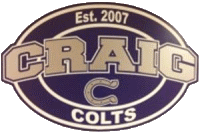
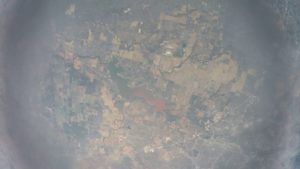

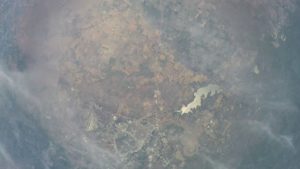

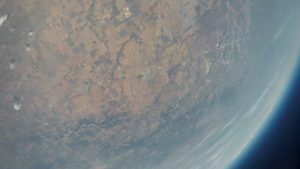
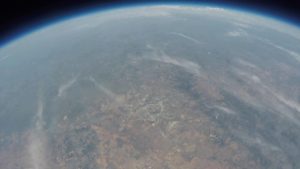

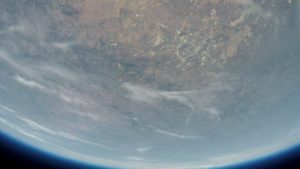
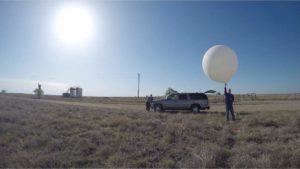
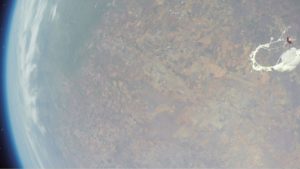
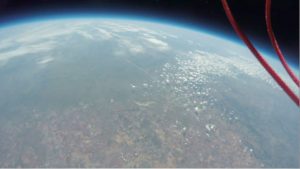

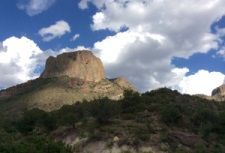
 On July 5, 2016, the moon passed between NOAA’s DSCOVR satellite and Earth. NASA’s EPIC camera aboard DSCOVR snapped these images over a period of about four hours. In this set, the far side of the moon, which is never seen from Earth, passes by. In the backdrop, Earth rotates, starting with the Australia and Pacific and gradually revealing Asia and Africa. Credits: NASA/NOAA
On July 5, 2016, the moon passed between NOAA’s DSCOVR satellite and Earth. NASA’s EPIC camera aboard DSCOVR snapped these images over a period of about four hours. In this set, the far side of the moon, which is never seen from Earth, passes by. In the backdrop, Earth rotates, starting with the Australia and Pacific and gradually revealing Asia and Africa. Credits: NASA/NOAA